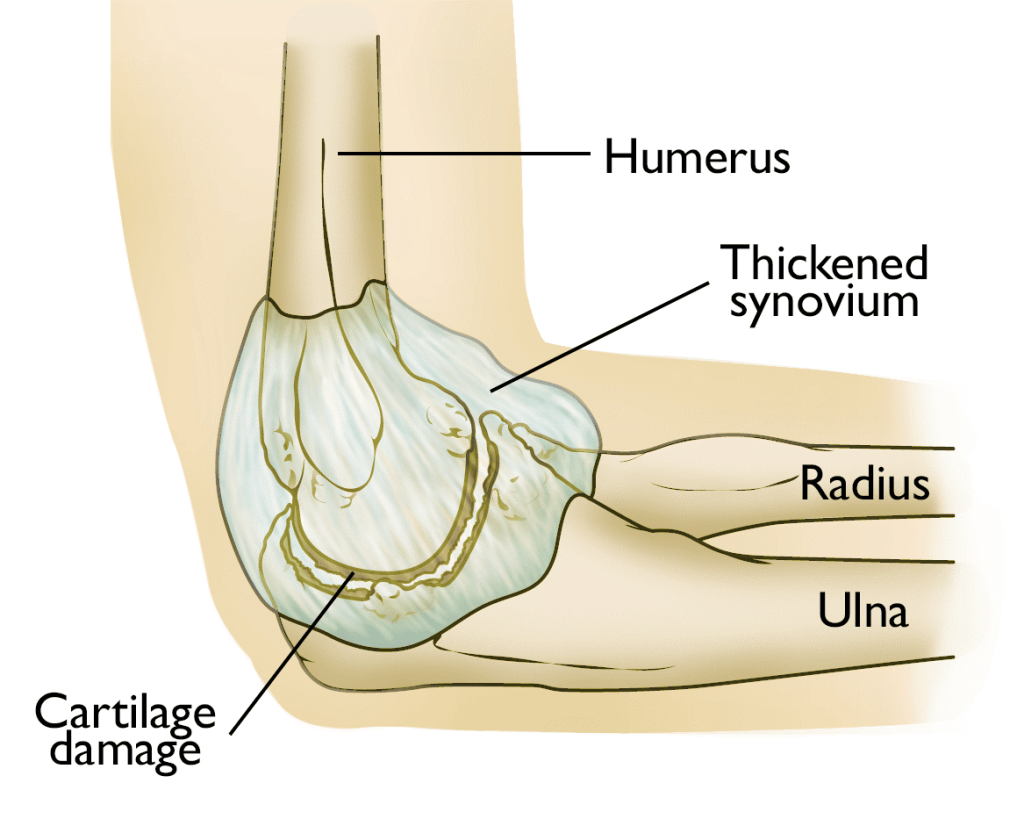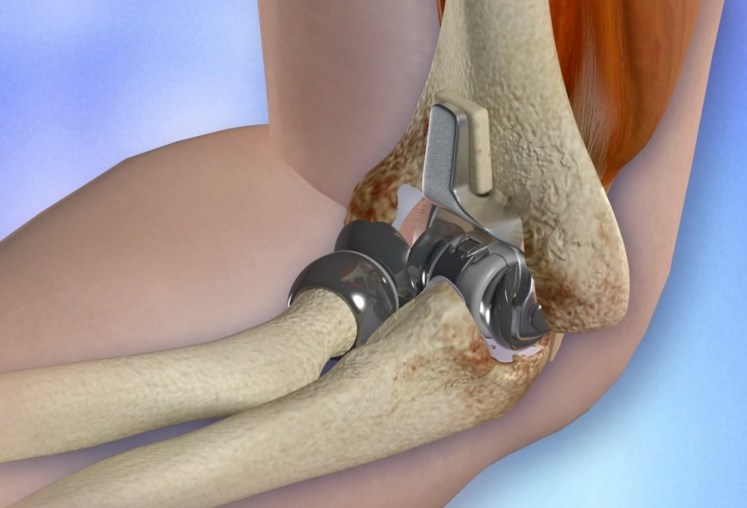In elbow replacement surgery, damaged elbow joint areas are removed and replaced with metal and plastic components (implants). Elbow arthroplasty is another name for this procedure.
In the elbow, three bones converge. The larger of the two forearm bones and the upper arm bone (humerus) are connected by a loose hinge (ulna). Together, the radius and ulna, the two forearm bones, provide rotation. The rate of complications following elbow replacement surgery has historically been higher than that following hip or knee replacement procedures. The success rate of elbow replacements has increased recently thanks to improvements in surgical procedure and implant design. Despite elbow joint replacements being much less common than knee, hip, or shoulder replacements, they are just as effective at reducing joint pain and allowing patients to resume their normal daily activities. This article will provide more information on elbow replacement surgery, whether you are just starting to research your options or have already made the decision.
Table of Contents
ToggleIn this article we will discuss:
- Why it’s done
- Elbow replacement procedures
- How to get ready
- What to expect
- Recovery
- pain management of elbow replacement surgery
- Final Words
- FAQ
Why it’s done
Elbow pain and disability can result from a number of conditions, which may prompt patients and their doctors to discuss elbow joint replacement surgery.
1- arthritis rheumatoid
The most prevalent type of the group of illnesses known as “inflammatory arthritis” is rheumatoid arthritis.
In this illness, the synovial membrane that covers the joint thickens and becomes inflamed. Chronic inflammation can harm cartilage, leading to eventual cartilage loss, discomfort, and stiffness.
2- Osteoarthritis (Degenerative Joint Disease)
Osteoarthritis is a wear-and-tear form of arthritis that develops with age. Although it can happen to younger people as well, it typically affects people over the age of 50. The cartilage that protects the elbow’s bones deteriorates and softens over time. Then the bones start to rub against each other. The elbow joint stiffens and hurts over time.

3- Arthritis after trauma
A severe elbow injury may be followed by this kind of arthritis. Over time, articular cartilage degradation may result from fractures of the elbow’s constituent bones or rips of the nearby tendons and ligaments. This impairs elbow function and creates pain.
4- Intense Fractures
Another frequent justification for elbow replacements is a serious fracture of one or more of the elbow’s bones. It could be quite challenging for a surgeon to reconstruct the elbow if it is fractured. Additionally, the bone fragments’ blood supply may be cut off. An elbow replacement may be suggested by a surgeon in this kind of scenario.
Additionally, some fractures don’t heal well, and an elbow replacement may be necessary to solve ongoing issues. The risk of serious elbow fractures is highest in older people with osteoporosis (fragile bone).
Elbow replacement procedures
In a total elbow replacement, artificial parts are used to replace the ulna and humerus’ damaged sections. The artificial elbow joint is constructed of two metal stems and a hinge made of metal and plastic. The stems fit inside the canal, a hollow area of the bone.
Elbow replacements come in a variety of styles, and parts are available in various sizes. In some very specific circumstances, partial elbow replacements may also be used. The best elbow replacement for you will be determined after talking with your doctor at Mediranco.
How to get ready for Elbow replacement surgery
1- Medical Assessment

Your orthopaedic surgeon may request that you schedule a comprehensive physical examination with your family doctor several weeks prior to surgery if you elect to have elbow replacement surgery. This is required to make sure you are in good enough health to have the procedure and recover fully. A professional, such as a cardiologist, must also assess a number of people with chronic medical disorders, including heart disease, prior to the procedure.
2- Medications
Make careful to discuss the medications you take with your orthopedic surgeon. Before surgery, several drugs might need to be stopped. For instance, the following OTC medications should be stopped two weeks before surgery since they may induce severe bleeding:
- Aspirin, ibuprofen, and naproxen are examples of non-steroidal anti-inflammatory drugs (NSAIDs).
- most medicines for arthritis
Your primary care physician or cardiologist will advise you about stopping blood thinners before to surgery if you take them. Before surgery, several anti-inflammatory drugs used to treat rheumatoid arthritis and other forms of inflammatory arthritis may need to be stopped. If you are using these medications, it is best to speak with your rheumatologist because you should typically stop taking them well before surgery.
What to expect in elbow replacement surgery
- Prior to the process
When it comes to eating, drinking, and taking medications the day before and the day of surgery, follow your surgeon’s instructions.
- Throughout the process
You will speak with a member of the Mediranco care team about how you will be sedated for the procedure. Most patients have both a nerve block and general anesthesia. You fall asleep quickly under a general anesthetic. Your arm becomes numb thanks to the nerve block so that pain management can continue even after you come out of general anesthesia. The average surgery lasts between one and two hours.
- following the procedure
You will spend some time recovering in the recovery area after surgery. The length of your hospital stay following surgery will depend on your specific requirements. On the same day, many folks can return home.
Recovery of Elbow replacement surgery
You will receive numerous doses of antibiotics from your medical team at Mediranco to ward off infection. The majority of patients are awake and able to move around the evening of surgery.
pain management of elbow replacement surgery
You’ll have some soreness after the procedure. This comes as a byproduct of healing naturally. Your surgeon and the nurses will attempt to lessen your discomfort so that you can recuperate from surgery more quickly.
Following surgery, medications are frequently administered for momentary pain relief. Opioids, non-steroidal anti-inflammatory drugs (NSAIDs), and local anesthetics are just a few of the medications that can be used to treat pain. To enhance pain relief and reduce the need for opioids, your doctor may combine these drugs.
Be advised that even though opioids aid in post-operative pain relief, they are narcotics and can have addictive properties. Overdose and addiction to opioids are now serious public health concerns. Opioids should only be used under your doctor’s supervision, and you should stop taking them as soon as your pain starts to subside. If your discomfort does not start to subside a few days after your surgery, consult your doctor.
Final Words
To reduce discomfort and regain motion in an injured elbow, physicians perform elbow replacement surgery, often known as total elbow arthroplasty. A surgeon replaces your elbow joint with an artificial joint during this procedure.
Not every elbow replacement operation involves the entire elbow. Some patients just have a portion of the joint replaced, such as the radial head (the knobby head of the radius bone where it meets the elbow).
Many people report an improvement in quality of life following elbow replacement surgery. You may be able to resume your favorite activities once the discomfort is reduced.

